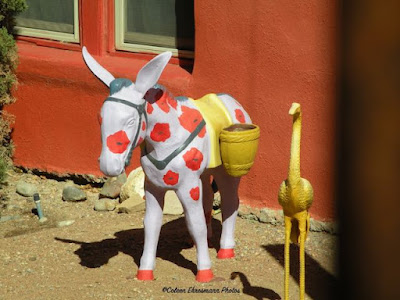The third town with a MUST STOP was Carrizozo. Hubby had it on his list because of the geocaches. But once again, it was so much more than a geocaching stop.
Carrizozo got its start because of the railroad. Today it is known as an artists community.The name of the town is derived from the Spanish vernacular for reed grass (Carrizo), which grew significantly in the area and provided excellent feed for ranch cattle. The additional "zo" at the end of the town name was added to indicate abundance of Carrizo grass. The town is now often referred to colloquially as "Zozo".
To the northeast is Carrizo Mountain, a 9,600-foot (2,900 m) peak within the Sacramento Mountains.
An attempt to entice travelers into exploring Carrizozo’s art spaces has grown into a Tularosa Basin phenomenon. Warren and Joan Malkerson, expat Minnesotans, turned their sights to this little town southeast of Socorro in 2005 and invested in a “herd” of aluminum burros. They invited local artists to paint the beasts, then set them outside businesses, along the roads, and atop a few buildings. Motorists who noticed them stopped into the couple’s Tularosa Basin Gallery of Photography and their Gallery 408. A feeding frenzy followed. “We’ve sold more than 400 of the painted burros,” Warren says. “They’re in more than 30 states.”
behind these doors...
...a drove of donkeys at Gallery 408
There are 26, maybe a few more, burros throughout the town. Some are advertising businesses, some in gardens and parks, some reside in the yards of the residents.
The original idea of branding the Carrizozo's quirky art scene with burros came from an old photograph that showed the animals standing along the town's historic Twelfth Street that is now home to a thriving artists' community.
"There were feral burros everywhere because people used them as work animals back in the day," Joan said.
Malkerson gets the bare metal forms in El Paso, imported from Mexico, and makes them available to local artists for trimming and sale, or also sometimes for charitable auctions.
once a thriving community
now homes and studios of artists using different mediums
a gathering place between two buildings
there were other gathering spots along 12th Street
interesting wall art "Crop Circles"
with a geocache under that rock
along US Routes 54 and 380
ice cream shop
it didn't look open for business
keeping an eye on the traffic
They are enough of a landmark that Warren happened to find a picture of a burro perched on top of the Highway 54 Emporium building in Carrizozo while thumbing through a copy of a National Geographic Travel magazine.
watching over 12th Street
my favorite
some of the burros advertise businesses,
like this one along Highway 380
After exploring the town, we did not see many options for lunch. We drove back to ZZQ and had a wonderful conversation with one of the owners. She commented on the increase in their sandwich business because of folks coming to town for geocaching. The pork sandwiches were delicious!
So, are they donkeys or are they burros? According to Wikipedia:
Burro is a word for donkey in both Spanish and Portuguese. In the United States, it is commonly applied to the feral donkeys that live west of the Rocky Mountains; in some areas it may also refer to any small donkey.
The first donkeys came to the Americas on ships of the Second Voyage of Christopher Columbus, and were landed at Hispaniola in 1495. The first to reach North America may have been two animals taken to Mexico by Juan de Zumárraga, the first bishop of Mexico, who arrived there on 6 December 1528, while the first donkeys to reach what is now the United States may have crossed the Rio Grande with Juan de Oñate in April 1598. From that time on they spread northward, finding use in missions and mines. Donkeys were documented as present in what today is Arizona in 1679. By the Gold Rush years of the 19th century, the burro was the beast of burden of choice of early prospectors in the western United States. With the end of the placer mining boom, many of them escaped or were abandoned, and a feral population established itself.



















No comments:
Post a Comment
Thanks for your comments!